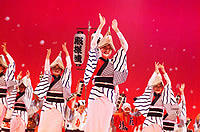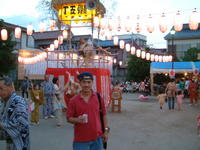:::::::::::::::::::::::::::::::::::::::::::::::::::::::::::::::::::::::::::::::::::::::::::::::::::::
Bird Haze in Spring (torigumori)
***** Location: Japan
***** Season: Mid-Spring
***** Category: Heavens
*****************************
Explanation
Dull and hazy weather in mid spring, when all kinds of migrating birds in great numbers start flying back to the North. The clouds and the sky of these days are pictured in the following kigo:
"bird haze" torigumori 鳥曇 とりぐもり
"birds and clouds" torikumo 鳥雲
"birds and wind", torikaze 鳥風
We also have other kigo with the haze (kumori, -gumori 曇り), meaning a cloudy day. KUMORI is usually used for an overcast sky.
flower haze, hanagumori 花曇 (はなぐもり)
(late spring)
..... "flower-nurishing sky", yookaten 養花天
"herring haze", nishingumori, 鰊曇 (にしんぐもり)
cloudy weather during the herring-fishing season
(late spring)
..... "herring sky" nishinzora 鰊空
At the side of the Nihonkai in Hokkaido, from March till May, when the fishing season for herring starts and the sky is mostly overcast. The weather is still unstable and many a fishing boat is lost in a sudden storm. In recent years, the catch has become smaller and smaller and less sons take up the family fishing business in the area. This is a rather local kigo.
Do not mix this with the "sardine clouds", iwashigumo, or mackerel clouds, named for the shape of the clouds.
...mackerel-clouds-iwashigumo
*****************************
Worldwide use
*****************************
Things found on the way
Birds and Clouds .. Kumo ni Tori .. 雲に鳥
Matsuo Basho, when in Osaka in 1694 (Genroku 7), wrote:
此(この)秋は何で年よる雲に鳥
kono aki wa nande toshiyoru kumo ni tori
This autumn,--
Old age I feel
In the clouds, the birds.
?In the birds, the clouds.
Blyth's translation and comment:
"It is evening. Basho is on a journey, his last; half a month later he will be dead. ... The onomatopoeia of this verse is striking; Basho sounds as if sobbing or choking."
This autumn--
why am I growing old?
bird disappearing among clouds.
Robert Hass' translation and comment:
"Written ten days or so before his death. The middle phrase is "nande toshiyoru," also possibly, "why am I so old?" or "why do we grow old?" Robert Aitken translates it in "A Zen Wave," "Somehow I have grown old." The last phrase is "kumo ni tori," literally, "to the clouds, a bird." Commentators have found it inexpressibly poignant. I can't find, and haven't seen, an adequate rendering."
Makoto Ueda's translation and note:
headnote: "A wanderer's thought"
this autumn
why am I aging so?
to the clouds, a bird
"NOTE:
Written on the same day and at the same place as the previous hokku."
[The previous hokku in Ueda's "Basho and His Interpreters" is:
kono michi ya yuku hito nashi ni aki no kure
headnote: "Expressing how I feel"
on this road
where nobody else travels
autumn nightfall
"The opening verse of a half-kasen composed at an Osaka restaurant on November 13, 1694"]
Back to the first Basho haiku:
this autumn
why am I aging so?
to the clouds, a bird
In the exerpts from the seven commentators from whom Ueda quotes, none mentions a mixing of kigo, or that "kumo ni tori" is a traditional spring kigo.
Quoting one of the exerpts:
"The concluding phrase presents a bird disappearing into the clouds, a solitary bird that looks like a fading speck. In relation to the rest of the poem, the phrase creates a kind of shock effect. The effect is more forceful than that of juxtaposition, so forceful, indeed, that it seems to make sparks fly. The poet succeeds in conveying a deep allegorical message about human life."
- Yamamoto
I wonder if Issa (see the HAIKU below) might have changed the phrase in his haiku from "kumo ni tori" to "ten ni hibari" because of awareness of Basho's use of the phrase.
Larry Bole discussing these two haiku
Translating Haiku Forum
The migrating birds of autumn seem to be sucked up and disappearing in the clouds.
The poet's own life seems also to come to an end.
quote
This autumn
Why am I aging so?
Flying towards the clouds, a bird.
The poem indicates Basho's awareness of approaching death. Shortly afterward he took to his bed with a stomach ailment, from which he was not to recover. Numerous disciples hurried to Osaka and gathered at his bedside. He seems to have remained calm in his last days. He scribbled a deathbed note to his elder brother, which in part read:
"I am sorry to have to leave you now. I hope you will live a happy life under Mataemon's care and reach a ripe old age.
There is nothing more I have to say."
The only thing that disturbed his mind was poetry. According to a disciple's record, Basho fully knew that it was time for prayers, not for verse writing, and yet he thought of the latter day and night. Poetry was now an obsession - "a sinful attachment," as he himself called it.
Makoto Ueda
source : terebess.hu
this autumn
Why do I feel so old?
A bird in the clouds
Tr. Peipei Qiu
Voice of animals, naku hibari 啼く雲雀 the skylark
. Matsuo Basho 松尾芭蕉 - Archives of the WKD .
.................................................................................
Cet automne-ci -
pourquoi donc dois-je vieillir ? -
oiseau dans les nuages
source : ElieDeLeuze . www.forumjapon.co
*****************************
HAIKU
雲に鳥人間海にあそぶ日ぞ
kumo ni tori ningen umi ni asobu hi zo
Kobayashi Issa
birds in the clouds
people in the sea...
a holiday
Jean Cholley sees this as a scene of people gathering shellfish at low tide. At the end of Third Month seabirds have migrated north ("in the clouds"), leaving good pickings for the humans; En village de miséreux: Choix de poèmes de Kobayashi Issa (Paris: Gallimard, 1996) 234, note 9.
Issa later (1795) revises this to begin with "larks in the sky" (ten ni hibari). Larks are not migratory birds.
Translation by David Lanoue
天に雲雀人間海にあそぶ日ぞ
ten ni hibari ningen umi ni asobu hi zo
larks in the sky
people in the sea...
a holiday
Sakuo Nakamura notices the "interesting contrast" between the vertical (birds in the clouds) and the horizontal (the sea). And the poem ends, he adds, with the psychological: it's a holiday, no work!
Tr. David Lanoue
Issa Haiku about Larks
:::::::::::::::::::::::::::::::::::::::::::::::::::::::::::::::::::::::::::::::::::::::::::::::::::::

鳥曇マニキュア落としさくらいろ
(とりぐもり まにきゅあおとし さくらいろ)
© ningyo-hime, exblog.jp
*****************************
Related words
***** Lark (hibari) various seasons
spring
Sometimes they fly so high, we almost loose sight of these first harbingers of spring. Then they plunge straight down, back to earth. They sit on the electricity lines of our home and twitter happily for a long time.
first lark, hatsu hibari 初雲雀(はつひばり)
hime hinadori ひめひな鳥(ひめひなどり), koku tenshi, koo tenshi 告天子(こくてんし), kyoo tenshi 叫天子(きょうてんし)
nest of a lark, hibari no su 雲雀の巣
lark high up, age hibari 揚雲雀(あげひばり)
lark coming down, ochi hibari 落雲雀(おちひばり)
lark in the morning, asa hibari 朝雲雀(あさひばり)
lark in the evening, yuu hibari 夕雲雀(ゆうひばり)
larks dancing, mai hibari 舞雲雀(まいひばり)
all the larks, moro hibari 諸雲雀(もろひばり)
"friend larks", tomo hibari 友雲雀(ともひばり)
field with larks, hibari no 雲雀野(ひばりの)
basket for larks, hibari kago 雲雀籠(ひばりかご)

... ... ...
lark in the fields, ta hibari 田雲雀 たひばり
kigo for late autumn
"dog lark" inu hibari 犬雲雀(いぬひばり)
"lark on the path" aze hibari 畦雲雀(あぜひばり), mizo hibari 溝雲雀(みぞひばり)
lark at the lake, kawa hibari 川雲雀(かわひばり)
lark on the earth, tsuchi hibari 土雲雀(つちひばり)
xxxxxxxxxxxxxxxxxxxxxxxxxxxxxxxxxxxxx
winter
lark in winter, fuyu hibari 冬雲雀 (ふゆひばり)
more LARK kigo are here
BIRD SAIJIKI
.................................................................................
永き日も囀り足らぬひばり哉
nagaki hi mo saezuri taranu hibari kana
all day long
singing and not enough yet -
this lark
Tr. Gabi Greve
. Matsuo Basho 松尾芭蕉 - Archives of the WKD .
Long Day (nagaki hi)
:::::::::::::::::::::::::::::::::::::::::::::::::::::::::::::::::::::::::::::::::::::::::::::::::::::
skylark
soaring skylark -
what do you think
of the limitless sky?
Tr. Donegan
. Chiyo-Ni 千代尼 .
:::::::::::::::::::::::::::::::::::::::::::::::::::::::::::::::::::::::::::::::::::::::::::::::::::
Meadowlark
Meadowlarks are birds belonging to the genus Sturnella in the New World family Icteridae.
This genus includes seven species of largely insectivorous grassland birds. In all species the male at least has a black or brown back and extensively red or yellow underparts.

Long-tailed MeadowlarkSturnella loyca
© More in the WIKIPEDIA !
broken glass
the meadowlark's voice cracks
this empty sky
The meadowlark is the representative bird for the state of Wyoming.
- Shared by Deborah Barbour Lundy -
Joys of Japan, September 2012
:::::::::::::::::::::::::::::::::::::::::::::::::::::::::::::::::::::::::::::::::::::::::::::::::::
***** Clouds (kumo) . Sea of Clouds (unkai)
***** Migrating Birds (wataridori) (Japan)
:::::::::::::::::::::::::::::::::::::::::::::::::::::::::::::::::::::::::::::::::::::::::::::::::::
BIRD SAIJIKI
[ . BACK to WORLDKIGO . TOP . ]
:::::::::::::::::::::::::::::::::::::::::::::::::::::::::::::::::::::::::::::::::::::::::::::::::::::

































